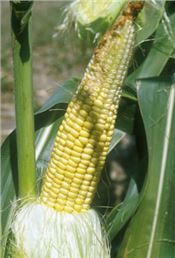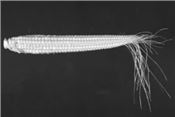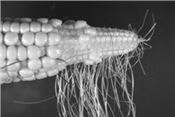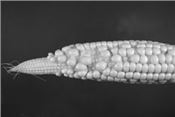|
Corn Ears Can Talk
DR. WILLIAM J. WIEBOLD
COLUMBIA, MO.
Scouting corn fields after pollination is difficult, but observing corn ears can provide information that helps estimate yield potential. Those ears can also provide clues about what went right and what went wrong during the most critical period of corn yield establishment, pollination/fertilization.
Before pollination, the corn ear is a collection of about 1000 female flowers. The structure that will, if all goes well, become a kernel is an ovule. Each ovule has one silk attached. Just prior to stage R1, all 1000 silks elongate underneath the husks and emerge from the husks. If timing is correct, pollen is shed from the tassel onto the silks. Pollen grains then germinate and pollen tubes grow inside the silks the entire distance to the ovule. Male and female gametes join during fertilization and kernels are formed. It's an amazing process, but in a good year it successfully happens 15 to 20 million times in each acre of corn.
Sometimes this pollination/fertilization process does not result in a kernel. Silks from ovules near the ear tip begin elongation last and do so slower than other silks. They are the last to emerge and are often covered by other silks. Because of this, these silks sometimes do not capture pollen grains. Figure 1 illustrates a normal, unstressed ear late in stage R1. The husks have been carefully removed. Notice that the only remaining silks are near the tip. Silks detach from ovules after fertilization has occurred. So, this ear has excellent fertilization throughout the ear. The ovules near the tip have not been fertilized, but in this field pollen was still being shed.
There are two primary causes that prevent ovule fertilization. The first cause is related to slow silk elongation. If water availability is limited during silk elongation, elongation slows. The tassel develops at its normal pace. Pollen shed may be complete before all silks have emerged. Because tip silks are last to emerge, these are the silks most likely to miss pollen. Figure 2 illustrates an ear that was drought stressed. Although the ear is past R2 stage, silks are still attached at the tip indicating lack of fertilization. The tip ovules were not fertilized and no kernel growth has occurred.
The second challenge to ovule fertilization occurs during the 24 hours between pollen grain germination and ovule fertilization. Silks must remain fully turgid for the pollen tubes to grow. If weather is hot and/or dry, silks may lose water and pollen tube growth stops. Since the pollen tube does not reach the ovule, fertilization cannot happen. Ovules not fertilized because of silk damage may occur anywhere on the ear. The location depends on when stress occurred. Figure 3 is an ear severely impacted by drought. There is a large region of unfertilized ovules at the tip, but there are also unfertilized ovules scattered across other areas of the ear.
If an ovule is not fertilized there is no kernel growth. The tissue you see is cob tissue. This tissue will take on a chaffy appearance as the ear continues to develop and is easily identified. At maturity the cob dries and any areas of missed fertilization shrink and may not be readily noticeable.
Sometimes fertilization takes place, but the developing kernel aborts and stops development. Kernels within the ear compete with each other for sugars, mineral nutrients, and water. Because of the path these nutrients take as they enter the ear from the stalk and spread though the ear, kernels at the tip are at a competitive disadvantage. These tip kernels are most likely to exhibit arrested development.
Kernel growth depends on a continual supply of sugars from photosynthesis, so factors that reduce photosynthesis will affect kernel growth. Drought stress causes leaf stomates to close, leaves to roll, and can greatly reduce photosynthesis. Overcast skies with thick clouds may also increase arrested development if this weather pattern lasts several days. Unfortunately, once kernel development is arrested, it cannot be restarted even if conditions improve.
Figure 4 illustrates an ear in which many kernels have stopped development. Some tip kernels were never fertilized, but many other kernels within the top one half of the ear have stopped development. Arrested kernels look different then unfertilized ovules and often show obvious signs of development including size and color. Figure 2 was used to illustrate unfertilized ovules, but the ear tip also contains a few kernels with arrested development.
Agronomists refer to the symptoms in figures 1 through 4 as “tip dieback” or “tipback”. Some tip dieback is normal. If corn planting rates are managed to maximize yield some dieback may be noticeable. This is an indication that there is adequate ear number to produce maximum yield. At these stand densities, competition for light and space among plants occurs and results in a small amount of dieback. Of course, the number of ears more than makes up for a small reduction in ear size. ∆
DR. WILLIAM J. WIEBOLD: Professor, Division of Plant Sciences, University of MissourI

Corn ear illustrating large area of aborted kernels.

Corn ear at late R1 stage.

Corn ear affected by drought. Notice unfertilized ovules on tip.

Corn ear affected by severe drought. Notice unfertilized ovules scattered throughout ear.
|
|